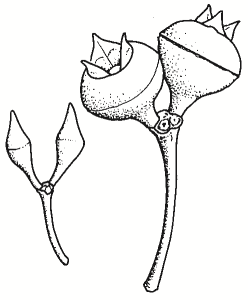Family:
Myrtaceae
Eucalyptus macrorhyncha
Red Stringybark
Other Names:
First Nations Name(s):

Name Origin:
macrorhyncha — from Greek macros, large, and rhynchos, beak, referring to operculum or cap, especially on buds.
Common name refers to bark and probably inner-bark colour.
Regional Subspecies:
Similar Species:
Distinguished from Broad-leaved Peppermint (E. dives) mainly by its larger fruit of different shape, and juvenile foliage.
Occurrence:
Regional:
Widespread in many catchments and districts, particularly east of Olympic Highway.
Australia:
NSW, Vic, SA.
Habitat:
Dry sclerophyll forest or woodland. Shallow poor soils on rises.
Habit:
Upright tree to 30 m high (and often less) with grey to red-brown stringy bark. Green adult leaves.
Site Preference:
Well-drained, moderately fertile soil. Tolerates frost, hot dry conditions and harsh sites.
Characteristics:
Moderate growth rate.
Flowering:
White-cream, Jan-Apr. Profuse and conspicuous.
Seed Collection:
Mainly summer, although seeds held for many years. Extract seeds from old woody capsules by heating in oven at 200°C for 15 minutes.
Propagation:
From seed (± 68 viable seeds per gram). 16°C is optimum germination temperature. Seedlings may not survive in sterile potting mix; adding local soil or leaf litter should overcome problems.
Regeneration:
From seed, particularly in absence of competitive exotic grasses and weeds, during wet, cool summers. Establishes well when direct seeded.
VALUES:
Shade & Shelter:
Useful medium-level cover in windbreaks. Good shade due to dense compact crown. Allows grass to grow to its base. Requires fencing to prevent ringbarking from stock, particularly cattle seeking roughage and rutin. Stock camps and trampling damage the surface roots.
Land Protection:
Useful to revegetate hilly recharge sites.
Wildlife:
Good habitat. Flowers are a nectar source for many native insects, birds and mammals. Insect- eating birds such as pardalotes attracted. Native birds including flycatchers, fantails, wrens, thornbills, honeyeaters and whistlers use bark for nesting material. Hollows close to ground- level are important nesting sites for Turquoise Parrot.
Fuel:
Fair. Easily split and ignited. Produces few sparks.
Timber:
Pale red-brown, moderately fine-textured, often with interlocked grain. Slow to dry, moderately durable and decorative. Density about 900 kg/m3. Used in flooring, as polishes well. Potential for use in furniture, veneers and shingles. Used for above-ground fencing such as rails, and for general construction. Becoming popular as feature timber.
Ornamental:
Shade for large gardens, although perhaps not particularly ornamental.
Other:
Leaves produce lemon dye, with mordant alum, or brown-green dye with chrome. Kino exuded from bark is astringent — substance that checks the discharge of mucus, serum etc. by causing tissue shrinkage. Leaves are a rutin source, which strengthens small blood vessel and capillary walls, and hence prevents nose bleeds etc.
